Performance of RC Beams under Shear Loads Strengthened with Metallic and Non-Metallic Fibers
Abstract
1. Introduction
Research Significance
2. Experimental Program
2.1. Main Parameters
2.2. Description of Test Specimens
2.3. Materials
2.4. Test Setup
Instrumentation
2.5. Test Procedures
2.6. Discussion of the Experimental Test Results
2.6.1. The Failure Mode and the Crack Pattern
2.6.2. The Load–Deflection Relationships
2.6.3. The Ultimate Failure-Load
2.6.4. Ultimate Deflection at the Ultimate Load
2.6.5. The Ductility Ratio
2.6.6. The Energy Absorption
3. Building Code Predictions
3.1. Shear Strength of Beams Strengthened with Ferrocement Wire Mesh, Vferro-cement
3.2. Shear Strength of Glass Fibre-Strengthed Beams
3.3. Shear Strength of Steel Fibre-Strengthed Beams
4. Comparison with Previous Reported Work
4.1. Provisions Proposed by Ghugal and Deshmukh [31]
4.2. Provisions Proposed by Naryanan and Darwish [33]
4.3. Provisions Proposed by Ashour, Hasanain, and Wafa [34]
4.4. Provisions Proposed by Al-Taan and Al-Feel in [35]
5. Conclusions
- The usage of 1.5% steel fibres is considered as the best for enhancing the ultimate load by 41.87% with respect to the control beam, but using 1.0% of steel fibres achieved the maximum value of load at first cracking, with an enhancement ratio of 10% with respect to the control beam.
- Using 1.5% of glass fibres achieved the maximum ductility ratio and energy absorption. The enhancement of energy absorption with respect to the control specimen was 47.94%.
- Incorporating two layers of expanded wire mesh enhanced the failure load, ductility ratio, and energy absorption by 10.48%, 63.44%, and 30.34%, respectively, with respect to the specimen strengthened with one layer of expanded wire mesh.
- Using two-layers of welded wire mesh enhanced the failure load, ductility ratio and energy absorption by 22.04%, 33.66% and 54.84%, respectively with respect to the specimen strengthened with a single layer of welded wire-mesh.
- Using two layers of welded wire mesh is better than using two layers of expanded wire mesh for improving the ultimate failure load.
- Using 1.5% of steel fibres is better than using 1.5% of glass fibres for increasing the ultimate load.
- The ECP and ACI provisions resulted in acceptable predictions of the shear capacity of specimens strengthened with ferro-cement wire mesh, where the mean predicted-to-experimental shear capacity ratios were 0.589 and 0.527 for ECP and ACI, respectively.
- The average predicted-to-experimental shear capacity ratios of specimens strengthened with glass fibres were 0.520, 0.474, and 0.565 with respect to the ECP, ACI, and reported research work [31,32], respectively. This shows that the ECP, the ACI, and the previous research work resulted in acceptable predictions of shear capacity for this type of strengthening.
- The mean predicted-to-experimental ratios for specimens strengthened with steel fibres were 0.502, 1.075, 0.736, 1.02, and 1.18 with respect to the ECP, ACI, and reported research work [33,34,35]. This means that the ACI predictions and provisions in these studies [34,35] overestimated the shear capacity for the beams strengthened with steel fibres, but the ECP predictions and provisions in this research [33] resulted in acceptable predictions of the shear strength of these beams.
- It is suggested that the results obtained from this research work, together with similar research works, should be implemented in the various codes of practice for beams strengthened with steel fibres under shear loading.
Author Contributions
Funding
Data Availability Statement
Conflicts of Interest
References
- Ibrahim, S.S.; Kandasamy, S.; Subashchandrabose, R.; Baskar, S.; Madhava, V. Performance enhancement of externally bonded reinforced concrete beams with 3D hooked-end steel fibres. Case Stud. Constr. Mater. 2022, 17, e01181. [Google Scholar]
- Abdullah, Q.N.; Abdulla, A.I. Flexural behavior of hollow self compacted mortar ferrocement beam reinforced by GFRP bars. Case Stud. Constr. Mater. 2022, 17, e01556. [Google Scholar] [CrossRef]
- Gideon, A.M.; Milan, R. Effects of nitinol on the ductile performance of ultra high ductility fibre reinforced cementitious composite. Case Stud. Constr. Mater. 2021, 15, e00582. [Google Scholar] [CrossRef]
- Zhang, Z.; Abbas, E.M.; Wang, Y.; Yan, W.; Cai, X.; Yao, S.; Tang, R.; Cao, D.; Lu, W.; Ge, W. Experimental study on flexural behavior of the BFRC-concrete composite beams. Case Stud. Constr. Mater. 2021, 15, e00738. [Google Scholar] [CrossRef]
- Hasnat, A.; Das, T.; Ahsan, R.; Alam, A.T.; Ahmed, H. In-plane cyclic response of unreinforced masonry walls retrofitted with ferrocement. Case Stud. Constr. Mater. 2022, 17, e01630. [Google Scholar] [CrossRef]
- Nguyen, T.K.; Nguyen, N.T. Finite element investigation of the shear performance of corroded RC deep beams without shear reinforcement. Case Stud. Constr. Mater. 2021, 15, e00757. [Google Scholar] [CrossRef]
- Murad, Y.; Abdel-Jabbar, H. Shear behavior of RC beams prepared with basalt and polypropylene fibers. Case Stud. Constr. Mater. 2022, 16, e00835. [Google Scholar] [CrossRef]
- Akkaya, H.C.; Aydemir, C.; Arslan, G. Investigation on shear behavior of reinforced concrete deep beams without shear reinforcement strengthened with fiber reinforced polymers. Case Stud. Constr. Mater. 2022, 17, e01392. [Google Scholar] [CrossRef]
- Jianbing, Y.; Yufeng, X.; Saijie, L.; Zhiqiang, X. Experimental study on shear performance of basalt fiber concrete beams without web reinforcement. Case Stud. Constr. Mater. 2022, 17, e01602. [Google Scholar] [CrossRef]
- Askar, M.K.; Hassan, A.F.; Al-Kamaki, Y.S. Flexural and shear strengthening of reinforced concrete beams using FRP composites: A state of the art. Case Stud. Constr. Mater. 2022, 17, e01189. [Google Scholar] [CrossRef]
- Alobaidy, Q.N.A.; Abdulla, A.I.; Al-Mashaykhi, M. Shear Behavior of Hollow Ferrocement Beam Reinforced by Steel and Fiberglass Meshes: Shear Behavior. Tikrit J. Eng. Sci. 2022, 29, 27–39. [Google Scholar] [CrossRef]
- Sarhat, S.R.; Abdul-Ahad, R.B. The combined use of steel fibers and stirrups as shear reinforcement in reinforced concrete beams. Spec. Publ. 2006, 235, 269–282. [Google Scholar]
- Gomes, L.D.D.S.; Oliveira, D.R.C.D.; Moraes Neto, B.N.D.; Medeiros, A.B.D.; Macedo, A.N.; Silva, F.A.C. Experimental analysis of the efficiency of steel fibers on shear strength of beams. Lat. Am. J. Solids Struct. 2018, 15, e86. [Google Scholar] [CrossRef]
- Iqbal, S.; Ali, I.; Room, S.; Khan, S.A.; Ali, A. Enhanced mechanical properties of fiber reinforced concrete using closed steel fibers. Mater. Struct. 2019, 52, 56. [Google Scholar] [CrossRef]
- Mohod, M.V. Performance of steel fiber reinforced concrete. Int. J. Eng. Sci. 2012, 1, 1–4. [Google Scholar]
- Panda, K.C.; Barai, S.V.; Bhattacharyya, S.K. Shear Strengthening of T-beam with GFRP. In Springer Transactions in Civil and Environmental Engineering; Springer: Berlin/Heidelberg, Germany, 2018. [Google Scholar]
- GHALI Mona Kamal, N. Behavior of Negative Moment Regions in Reinforced Concrete T-Beams Strengthened in Shear by CFRP. Master Thesis, Scientific Bulletin, Faculty of Engineering, Ain Shams University, Cairo, Egypt, June 2007. [Google Scholar]
- Ata, E.S.S.; Moustaf, O. Experimental analysis of RC beam strengthened with discrete glass fiber. Facta Univ.-Ser. Archit. Civ. Eng. 2011, 9, 205–215. [Google Scholar] [CrossRef]
- Murthy, Y.I.; Sharda, A.; Jain, G. Performance of glass fiber reinforced concrete. Int. J. Eng. Innov. Technol. 2012, 1, 246–248. [Google Scholar]
- El-Sayed, T.A.; Erfan, A.M. Improving shear strength of beams using ferrocement composite. Constr. Build. Mater. 2018, 172, 608–617. [Google Scholar] [CrossRef]
- Khalifa, A.; Belarbi, A.; Nanni, A. Shear performance of RC members strengthened with externally bonded FRP wraps. In Proceedings of the Twelfth World Conference on Earthquake, Auckland, New Zealand, 30 January–4 February 2000. [Google Scholar]
- Sawant, S.G.; Sawant, A.B.; Kumthekar, M.B. Strengthening of RCC beam-using different glass fiber. Int. J. Inven. Eng. Sci. 2013, 1, 1–8. [Google Scholar]
- Shehata, E.; Morphy, R.; Rizkalla, S. Fibre reinforced polymer shear reinforcement for concrete members: Behaviour and design guidelines. Can. J. Civ. Eng. 2000, 27, 859–872. [Google Scholar] [CrossRef]
- Hamid, N.A.A.; Thamrin, R.; Ibrahim, A. Shear capacity of non-metallic (FRP) reinforced concrete beams with stirrups. Int. J. Eng. Technol. 2013, 5, 593. [Google Scholar] [CrossRef]
- Kotynia, R.; Kaszubska, M.; Barros, J.A. Shear Behavior of Steel or GFRP Reinforced Concrete Beams without Stirrups. In High Tech Concrete: Where Technology and Engineering Meet; Springer: Cham, Switzerland, 2018; pp. 769–777. [Google Scholar]
- Deng, Y.; Ma, F.; Zhang, H.; Wong, S.H.; Pankaj, P.; Zhu, L.; Ding, L.; Bahadori-Jahromi, A. Experimental study on shear performance of RC beams strengthened with NSM CFRP prestressed concrete prisms. Eng. Struct. 2021, 235, 112004. [Google Scholar] [CrossRef]
- Megarsa, E.; Kenea, G. Numerical investigation on shear performance of reinforced concrete beam by using ferrocement composite. Math. Probl. Eng. 2022, 2022, 5984177. [Google Scholar] [CrossRef]
- E.C.P. 203/2020. Egyptian Code of Practice: Design and Construction for Reinforced Concrete Structures, Cairo, Egypt. 2020. Available online: https://www.scirp.org/reference/referencespapers?referenceid=52937 (accessed on 15 May 2024).
- ACI Committee 3. Building Code Requirements for Structural Concrete (ACI 318-19) and Commentary; American Concrete Institute: Indianapolis, IN, USA, 2019; Available online: https://www.amazon.com/318-19-Building-Requirements-Structural-Commentary/dp/1641950560 (accessed on 15 May 2024).
- Model Code 2010: Volume 1. Vol. 65. Fib Fédération Internationale du Béton. 2012. Available online: https://www.fib-international.org/publications/fib-bulletins/model-code-2010-final-draft,-volume-1-detail.html (accessed on 15 May 2024).
- Ghugal, Y.M.; Deshmukh, S.B. Performance of alkali-resistant glass fiber reinforced concrete. J. Reinf. Plast. Compos. 2006, 25, 617–630. [Google Scholar] [CrossRef]
- Russo, G.; Puleri, G. Stirrup effectiveness in reinforced concrete beams under flexure and shear. Struct. J. 1997, 94, 227–238. [Google Scholar]
- Narayanan, R.; Darwish, I.Y.S. Use of steel fibers as shear reinforcement. Struct. J. 1987, 84, 216–227. [Google Scholar]
- Ashour, S.A.; Hasanain, G.S.; Wafa, F.F. Shear behavior of high-strength fiber reinforced concrete beams. Struct. J. 1992, 89, 176–184. [Google Scholar]
- Al-Ta’an, S.A.; Al-Feel, J.R. Evaluation of shear strength of fibre-reinforced concrete beams. Cem. Concr. Compos. 1990, 12, 87–94. [Google Scholar] [CrossRef]

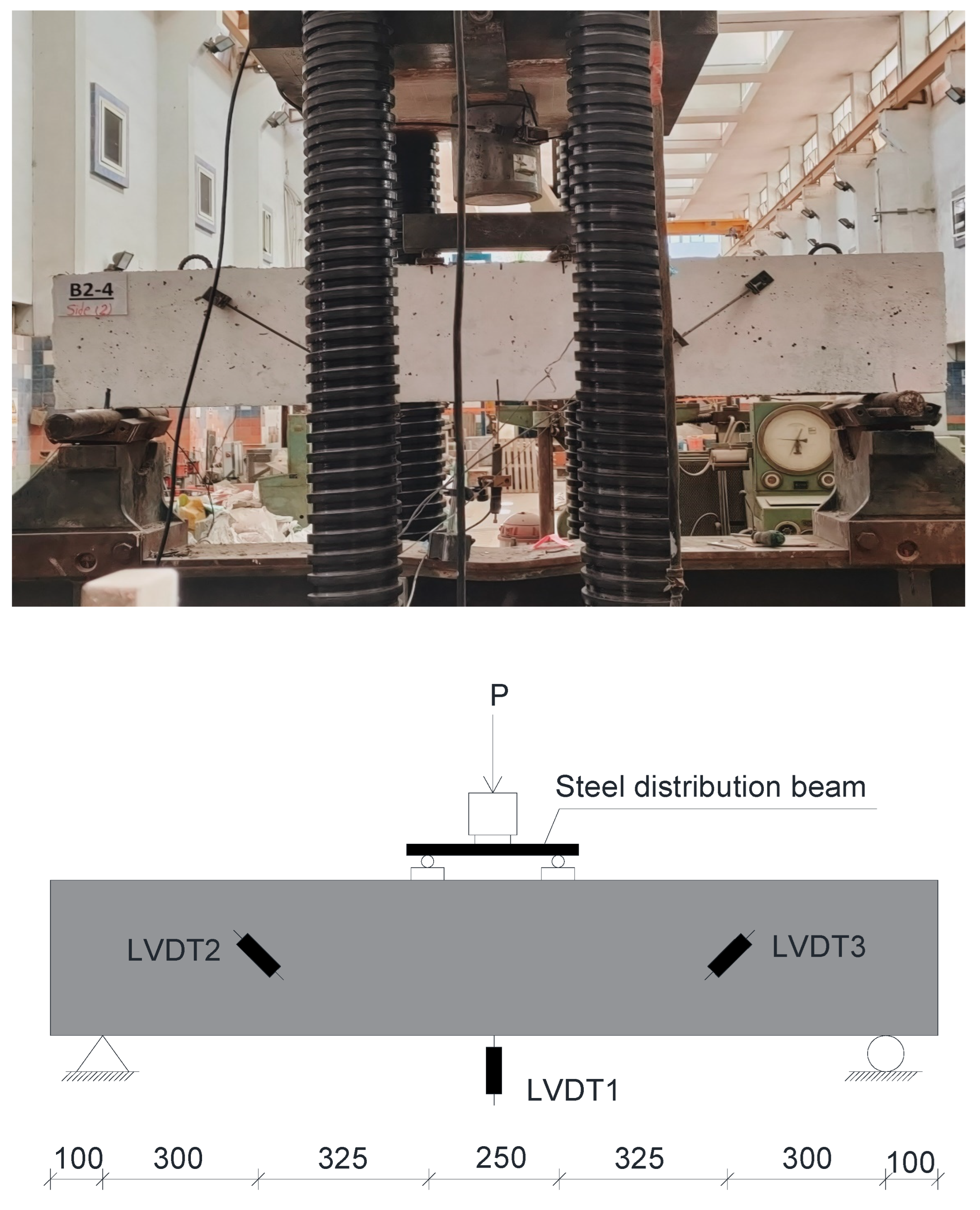
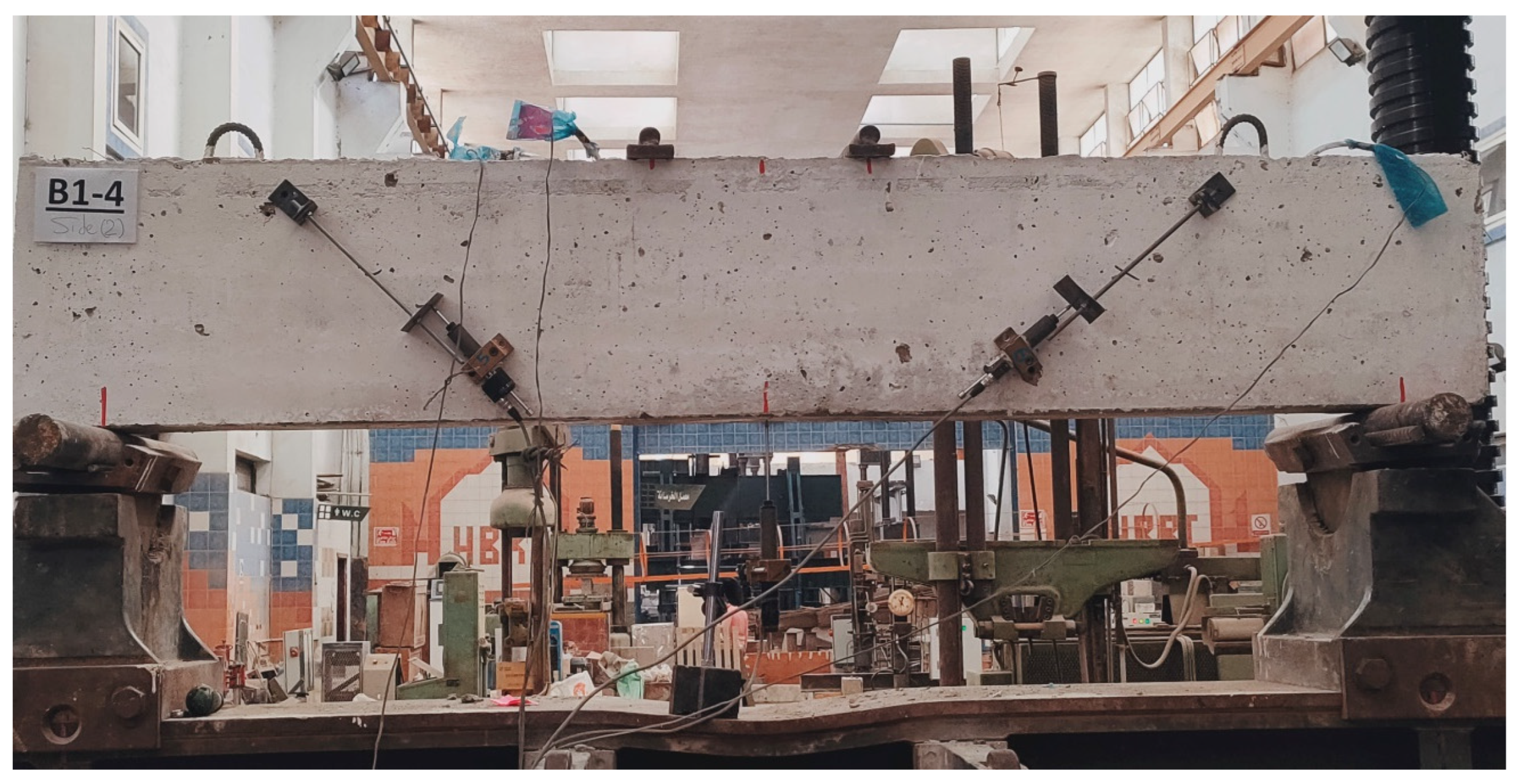


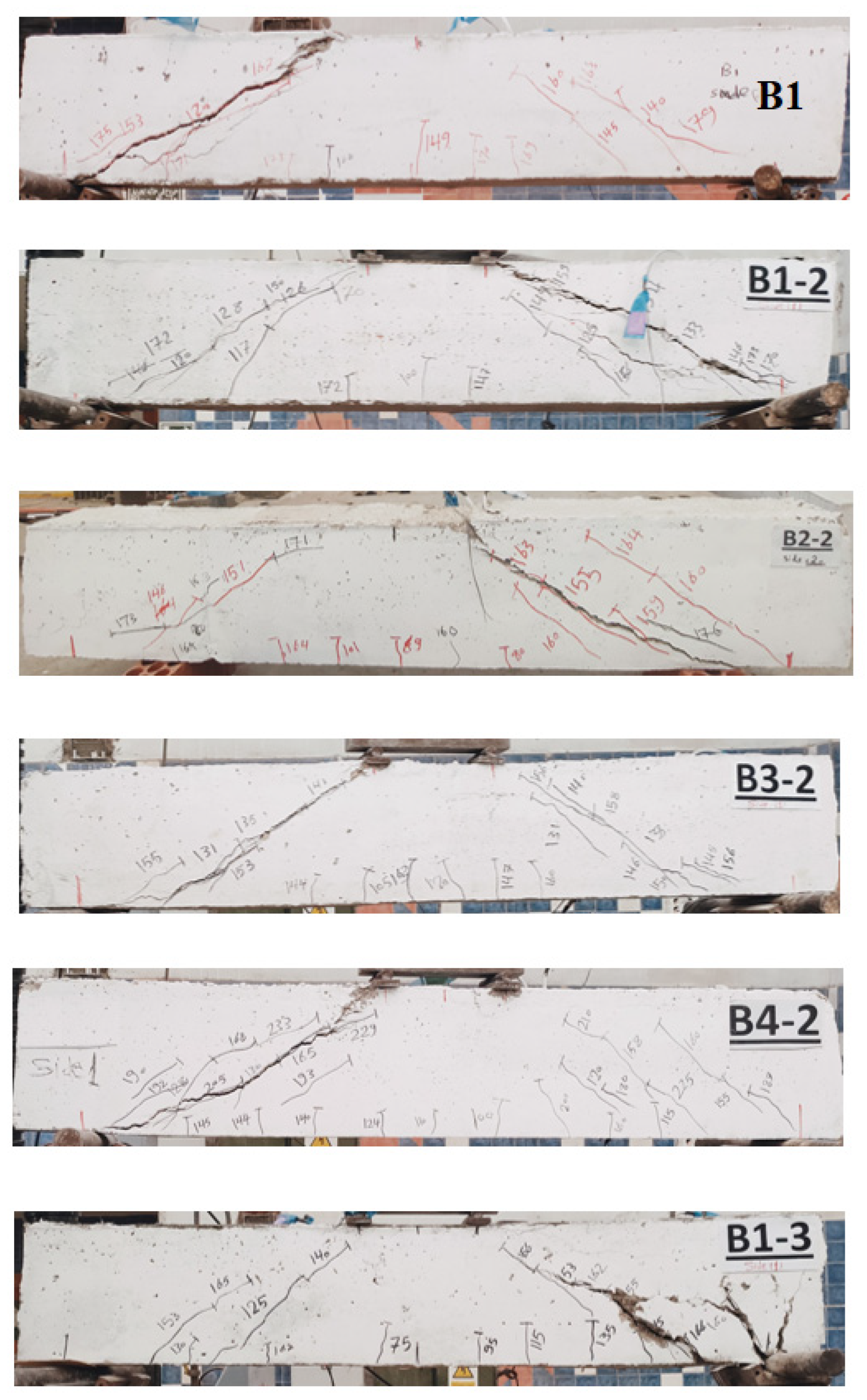

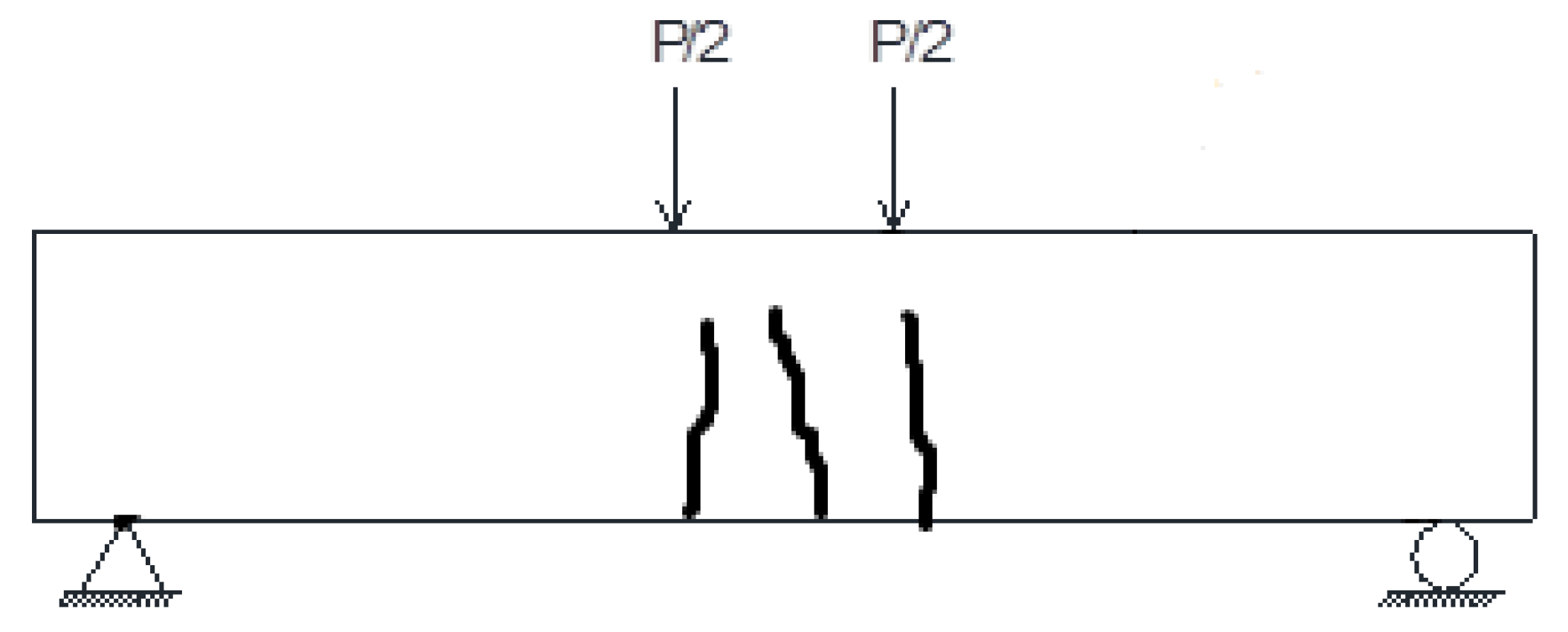

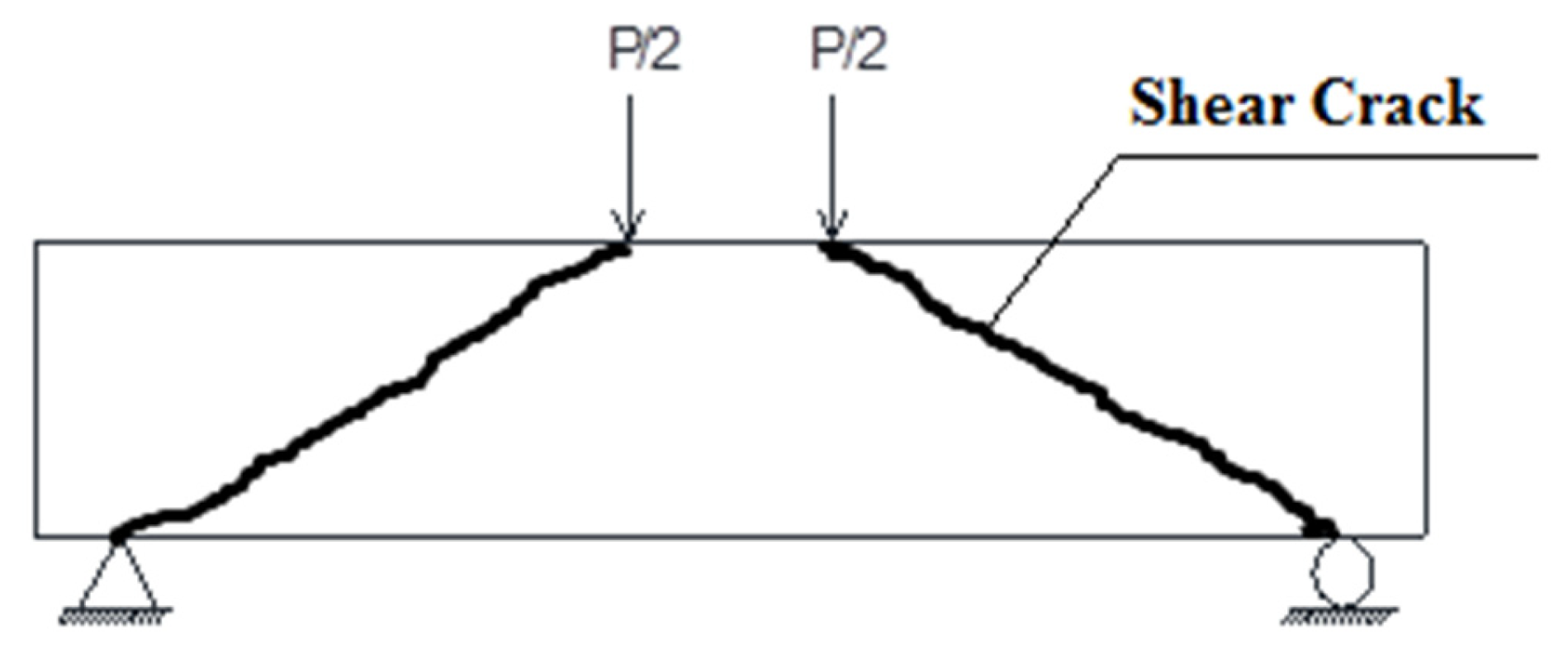



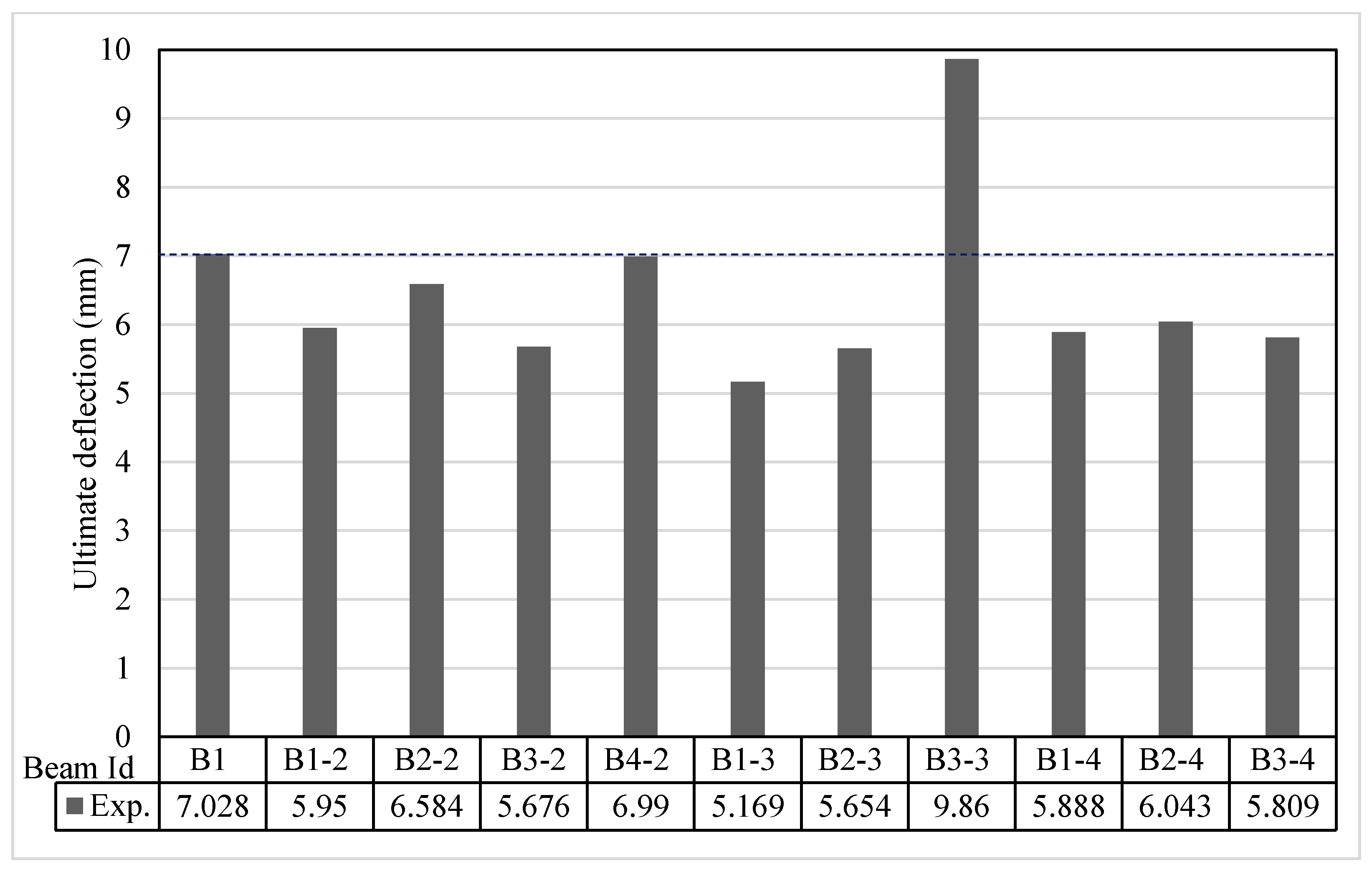
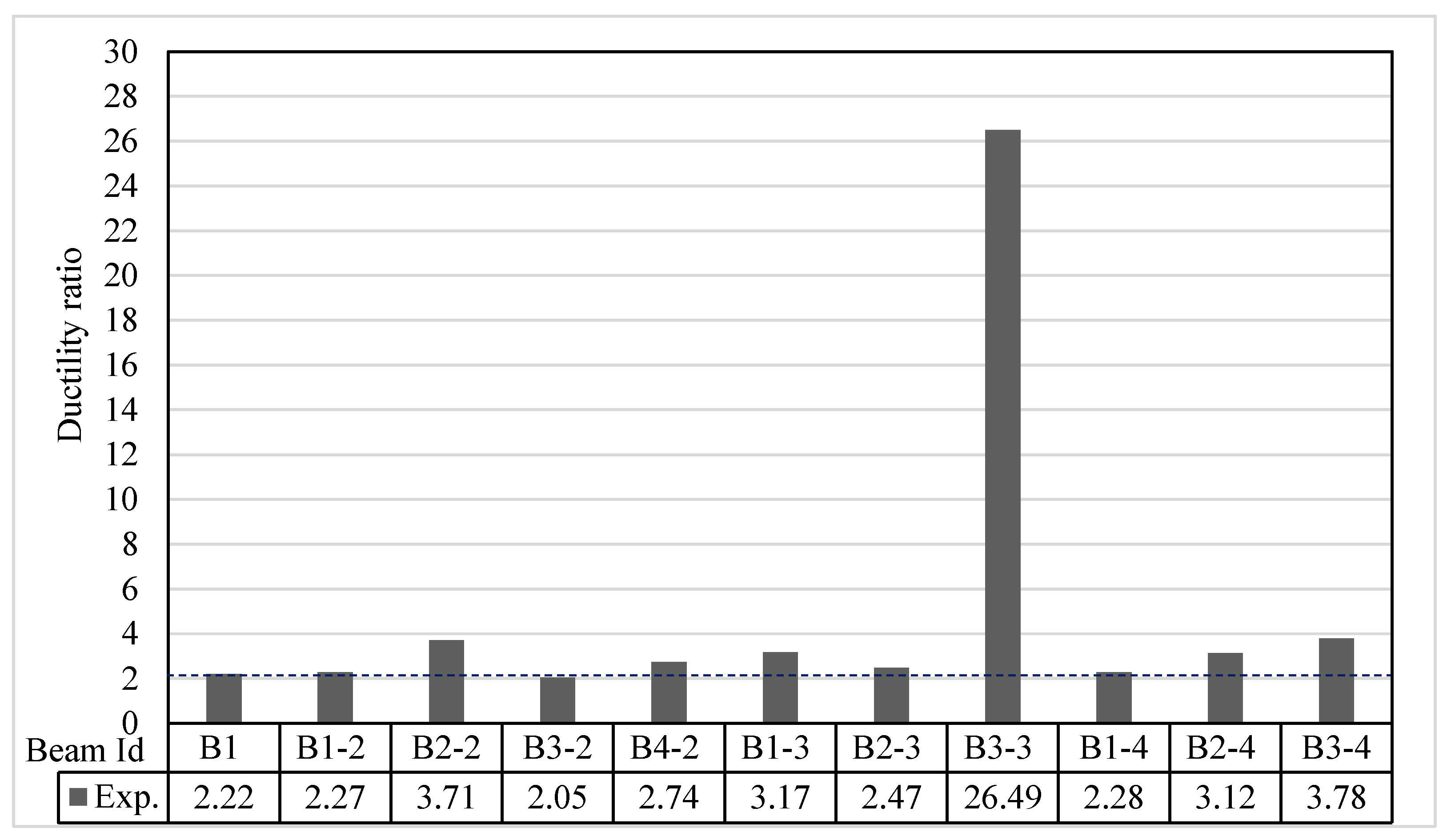

| Groups | Beam ID | Beam Description | Bottom RFT. | Top RFT. | Stirrups |
|---|---|---|---|---|---|
| G1 | B1 | Control beam | 4φ16 | 2φ12 | Φ6@200 |
| G2 | B1-2 | One-layer expanded wire-mesh | 4φ16 | 2φ12 | Φ6@200 |
| B2-2 | Two-layer expanded wire-mesh | ||||
| B3-2 | One-layer welded wire-mesh | ||||
| B4-2 | Two-layer welded wire-mesh | ||||
| G3 | B1-3 | 0.5% glass fibre | 4φ16 | 2φ12 | Φ6@200 |
| B2-3 | 1.0% glass fibre | ||||
| B3-3 | 1.5% glass fibre | ||||
| G4 | B1-4 | 0.5% steel fibre | 4φ16 | 2φ12 | Φ6@200 |
| B2-4 | 1.0% steel fibre | ||||
| B3-4 | 1.5% steel fibre |
| Mix | Cement (kg/ ) | Fine Aggregate (kg/) | Coarse Aggregate (kg/) | Water (kg/) | Steel Fibres (%) | Glass Fibres (%) |
|---|---|---|---|---|---|---|
| 1 | 350 | 640 | 1280 | 180 | For the control specimen and specimens, strengthened with wire meshes | |
| 2 | 350 | 640 | 1280 | 180 | 0 | 0.5 |
| 3 | 350 | 640 | 1280 | 180 | 0 | 1 |
| 4 | 350 | 640 | 1280 | 180 | 0 | 1.5 |
| 5 | 350 | 640 | 1280 | 180 | 0.5 | 0 |
| 6 | 350 | 640 | 1280 | 180 | 1 | 0 |
| 7 | 350 | 640 | 1280 | 180 | 1.5 | 0 |
| Mix | Slump (mm) | Temperature (°C) |
|---|---|---|
| 1 | 100 | 26 |
| 2 | 97 | 26 |
| 3 | 92 | 26 |
| 4 | 86 | 26 |
| 5 | 87 | 26 |
| 6 | 80 | 26 |
| 7 | 77 | 26 |
| Welded Wire-Mesh | Expanded Wire-Mesh | |
|---|---|---|
| Shape | 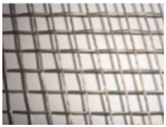 | 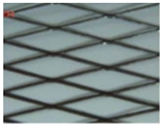 |
| Dimensions | 12 × 12 mm | 12 × 22 mm |
| Weight | 620 gm/ | 1720 gm/ |
| Sheet thickness | 0.7 mm | 1 mm |
| Yield stress | 400 MPa | 250 MPa |
| Ultimate strength | 600 MPa | 380 MPa |
| Type | End-Hooked Type |
|---|---|
| Shape |  |
| Surface | Clear, bright, and loose fibres with hook end anchorage |
| Length (L) | 50 mm |
| Diameter (D) | 1 mm |
| Aspect ratio (L/D) | 50 mm |
| Length of hook | 4–6 mm |
| Height of hook | 2.10–2.90 mm |
| Tensile strength | 1100 N/ |
| Density | 7850 kg/ |
| Tested Beams | First Crack-Load (kN) | Deflection at First Crack-Load (mm) |
|---|---|---|
| B1 (control) | 100.000 | 3.159 |
| B1-2 (one layer expanded) | 100.000 | 2.616 |
| B2-2 (two layers expanded) | 69.000 | 1.773 |
| B3-2 (one layer welded) | 105.000 | 2.772 |
| B4-2 (two layers welded) | 100.000 | 2.549 |
| B1-3 (0.5% glass fibre) | 75.000 | 1.593 |
| B2-3 (1.0% glass fibre) | 105.000 | 2.324 |
| B3-3 (1.5% glass fibre) | 55.000 | 0.266 |
| B1-4 (0.5% steel fibre) | 85.000 | 2.530 |
| B2-4 (1.0% steel fibre) | 110.000 | 1.728 |
| B3-4 (1.5% steel fibre) | 95.000 | 1.457 |
| Specimens | Description | (KN) | (KN) | (KN) | ||
|---|---|---|---|---|---|---|
| B1 | Control | 76.96 | 43.02 | 0.559 | 39.197 | 0.509 |
| B1-2 | 1 layer expanded | 86.97 | 50.33 | 0.579 | 45.79 | 0.527 |
| B2-2 | 2 layers expanded | 96.08 | 57.67 | 0.600 | 52.383 | 0.545 |
| B3-2 | 1 layer welded | 82.33 | 50.20 | 0.609 | 44.531 | 0.541 |
| B4-2 | 2 layers welded | 101.11 | 57.42 | 0.568 | 49.865 | 0.493 |
| B1-3 | 0.5% glass fibre | 80.19 | 44.839 | 0.559 | 40.871 | 0.509 |
| B2-3 | 1.0% glass fibre | 89.82 | 45.293 | 0.504 | 41.272 | 0.459 |
| B3-3 | 1.5% glass fibre | 91.65 | 45.664 | 0.498 | 41.629 | 0.454 |
| B1-4 | 0.5% steel fibre | 77.81 | 46.571 | 0.599 | 92.377 | 1.187 |
| B2-4 | 1.0% steel fibre | 99.77 | 47.19 | 0.473 | 102.845 | 1.031 |
| B3-4 | 1.5% steel fibre | 109.19 | 47.314 | 0.433 | 109.93 | 1.007 |
| Mean value | 0.46 | 0.66 | ||||
| S.D. | 0.052 | 0.272 | ||||
| C.O.V % | 11.3 | 41.2 | ||||
| Specimens | Description | (KN) | (KN) | (KN) | ||
|---|---|---|---|---|---|---|
| B1-2 | 1-layer-expanded | 86.97 | 50.33 | 0.579 | 45.79 | 0.527 |
| B2-2 | 2-layer-expanded | 96.08 | 57.67 | 0.600 | 52.383 | 0.545 |
| B3-2 | 1-layer-welded | 82.33 | 50.201 | 0.609 | 44.531 | 0.541 |
| B4-2 | 2-layer-welded | 101.11 | 57.42 | 0.568 | 49.865 | 0.493 |
| Mean value | 0.589 | 0.527 | ||||
| S.D. | 0.019 | 0.024 | ||||
| C.O.V % | 3.23 | 4.55 | ||||
| Specimens | Description | (KN) | (KN) | (KN) | ||
|---|---|---|---|---|---|---|
| B1-3. | 0.5% glass fibre | 80.19 | 44.839 | 0.559 | 40.871 | 0.509 |
| B2-3 | 1.0% glass fibre | 89.82 | 45.293 | 0.504 | 41.272 | 0.459 |
| B3-3 | 1.5% glass fibre | 91.65 | 45.664 | 0.498 | 41.629 | 0.454 |
| Mean value | 0.520 | 0.474 | ||||
| S.D. | 0.034 | 0.03 | ||||
| C.O.V | 6.50 | 6.33 | ||||
| Specimens | Description | (KN) | (KN) | (KN) | ||
|---|---|---|---|---|---|---|
| B1-4 | 0.5% steel fibre | 77.81 | 46.571 | 0.599 | 92.377 | 1.187 |
| B2-4 | 1.0% steel fibre | 99.77 | 47.19 | 0.473 | 102.845 | 1.031 |
| B3-4 | 1.5% steel fibre | 109.19 | 47.314 | 0.433 | 109.93 | 1.007 |
| Mean value | 0.502 | 1.075 | ||||
| S.D. | 0.087 | 0.098 | ||||
| C.O.V % | 17.33 | 9.11 | ||||
| Specimens | Description | (KN) | (KN) | |
|---|---|---|---|---|
| B1-4 | 0.5% steel fibre | 77.81 | 43.56 | 0.559 |
| B2-4 | 1.0% steel fibre | 99.77 | 71.94 | 0.721 |
| B3-4 | 1.5% steel fibre | 109.19 | 101.39 | 0.928 |
| Mean value | 0.736 | |||
| S.D. | 0.185 | |||
| C.O.V % | 25.14 | |||
| Specimens | Description | (KN) | (KN) | |
|---|---|---|---|---|
| B1-4 | 0.5% steel fibre | 77.81 | 83.08 | 1.068 |
| B2-4 | 1.0% steel fibre | 99.77 | 98.13 | 0.984 |
| B3-4 | 1.5% steel fibre | 109.19 | 112.49 | 1.03 |
| Mean value | 1.02 | |||
| S.D. | 0.043 | |||
| C.O.V % | 4.22 | |||
| Specimens | Description | (KN) | (KN) | |
|---|---|---|---|---|
| B1-4 | 0.5% steel fibre | 77.81 | 100.44 | 1.29 |
| B2-4 | 1.0% steel fibre | 99.77 | 113.19 | 1.13 |
| B3-4 | 1.5% steel fibre | 109.19 | 124.99 | 1.14 |
| Mean value | 1.18 | |||
| S.D. | 0.09 | |||
| C.O.V % | 7.63 | |||
Disclaimer/Publisher’s Note: The statements, opinions and data contained in all publications are solely those of the individual author(s) and contributor(s) and not of MDPI and/or the editor(s). MDPI and/or the editor(s) disclaim responsibility for any injury to people or property resulting from any ideas, methods, instructions or products referred to in the content. |
© 2024 by the authors. Licensee MDPI, Basel, Switzerland. This article is an open access article distributed under the terms and conditions of the Creative Commons Attribution (CC BY) license (https://creativecommons.org/licenses/by/4.0/).
Share and Cite
Ghali, M.K.N.; El-Sayed, T.A.; Salah, A.; Khater, N. Performance of RC Beams under Shear Loads Strengthened with Metallic and Non-Metallic Fibers. Buildings 2024, 14, 1869. https://doi.org/10.3390/buildings14061869
Ghali MKN, El-Sayed TA, Salah A, Khater N. Performance of RC Beams under Shear Loads Strengthened with Metallic and Non-Metallic Fibers. Buildings. 2024; 14(6):1869. https://doi.org/10.3390/buildings14061869
Chicago/Turabian StyleGhali, Mona K. N., Taha A. El-Sayed, Ahmed Salah, and Nora Khater. 2024. "Performance of RC Beams under Shear Loads Strengthened with Metallic and Non-Metallic Fibers" Buildings 14, no. 6: 1869. https://doi.org/10.3390/buildings14061869
APA StyleGhali, M. K. N., El-Sayed, T. A., Salah, A., & Khater, N. (2024). Performance of RC Beams under Shear Loads Strengthened with Metallic and Non-Metallic Fibers. Buildings, 14(6), 1869. https://doi.org/10.3390/buildings14061869









